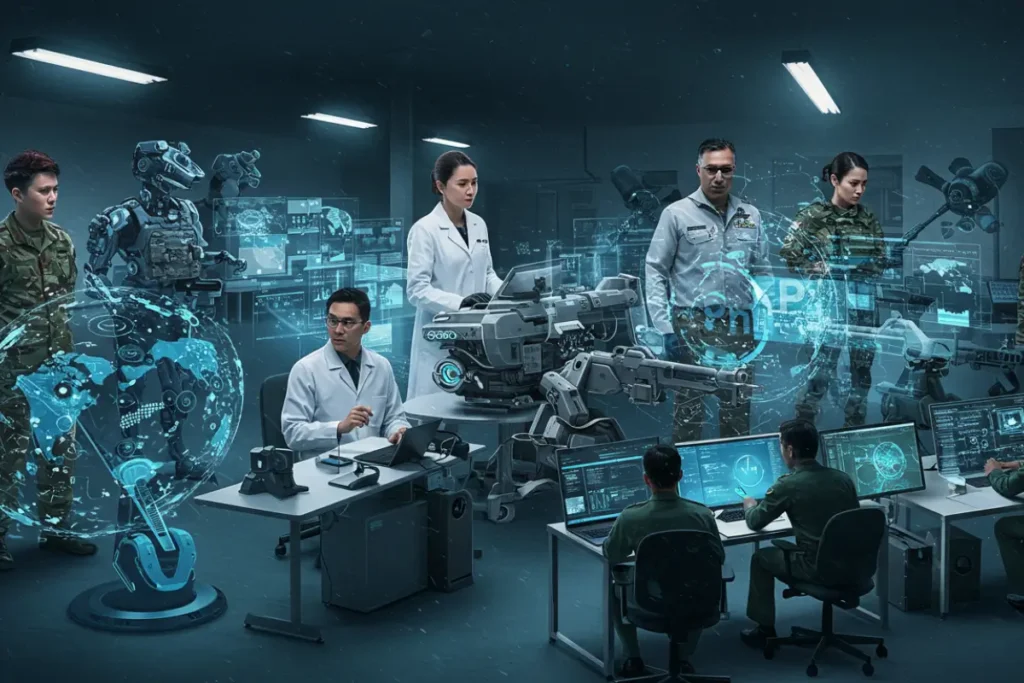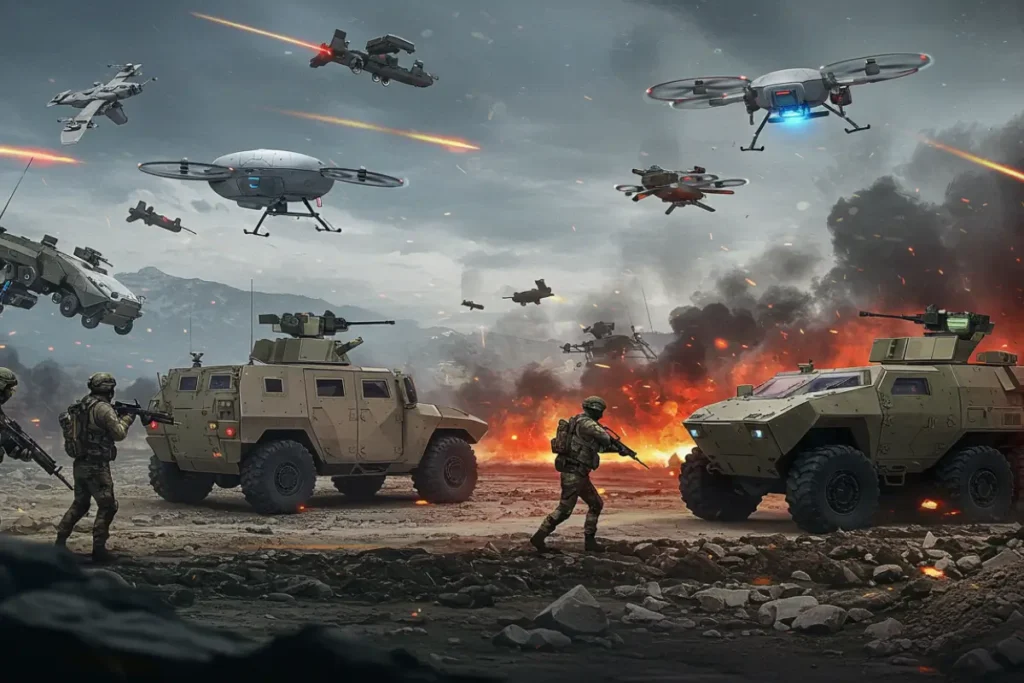How AI is Changing Warfare
- April 25, 2025
- 0
The Evolution of Warfare: From Muskets to Machine Learning War has always been shaped by technology. From the invention of gunpowder to nuclear weapons, each advancement has rewritten
The Evolution of Warfare: From Muskets to Machine Learning War has always been shaped by technology. From the invention of gunpowder to nuclear weapons, each advancement has rewritten

War has always been shaped by technology. From the invention of gunpowder to nuclear weapons, each advancement has rewritten the rules of combat. Now, artificial intelligence is stepping onto the stage — not as a weapon itself, but as the mind behind the weapons.
In the 21st century, AI is no longer science fiction; it’s military doctrine. What once took a general’s lifetime of experience can now be simulated and enhanced by an AI in seconds.
The shift began with data. Armies today don’t just fight with guns — they fight with information. Surveillance, satellite imagery, and digital communication form the backbone of strategy.
But raw data is useless unless it’s interpreted quickly.
That’s where AI shines. Machine learning algorithms can analyze real-time footage, detect patterns in enemy behavior, and even predict future movements with alarming accuracy.
This isn’t hypothetical. In conflicts across the world, including recent tensions in Eastern Europe and the Middle East, AI-driven tools have been deployed to guide reconnaissance drones, identify targets, and protect soldiers from ambushes.
Military strategists are now as likely to consult AI models as maps.
📰 See more on how AI influences the global stage: The Rise of AI-Powered Supercomputers

Drones were already game changers — but autonomous drones? That’s another level. AI allows drones to fly, identify threats, and strike — all without human intervention.
And while this sounds like something out of a sci-fi movie, it’s already being tested and, in some cases, deployed.
Autonomous drones use computer vision and deep learning to recognize vehicles, weapons, and even facial features.
They can track multiple targets, avoid obstacles, and adjust their mission objectives mid-flight. This makes them ideal for surveillance, search-and-rescue, and combat.
Military robots are no different. From robotic dogs used for carrying gear to AI-powered sentry bots guarding bases, the rise of autonomous military robotics is just beginning.
The question is no longer if these machines will be used, but how often and with what level of independence.
🔗 For more on AI in technology, read: AI-Powered NPCs: No More Repetitive Dialogue
Cyber warfare is the battlefield of the invisible, and AI is the digital soldier fighting these wars. Nations are investing billions in AI-powered cybersecurity systems that defend against malware, data theft, and sabotage attempts in real time.
These systems don’t just wait to be attacked — they learn. They monitor server logs, analyze behavior patterns, and automatically patch vulnerabilities.
AI is also used offensively, to create malware that can adapt to evade detection — a chilling reality.
Cyber defense systems like Google’s Chronicle or IBM’s QRadar use machine learning to understand new types of threats every day. With enough data, they can detect an intrusion before it even happens.
🔍 If you’re curious about AI tools in real-time, check this tool comparison: Google Gemini 1.5 vs ChatGPT-4

With great power comes great responsibility — and AI in warfare opens massive ethical questions. Should a machine decide who lives and who dies?
Should autonomous weapons be allowed to fire without human confirmation? These are questions the world is struggling to answer.
The United Nations has held multiple conferences to debate the legality of “killer robots.” Many experts argue that without strict regulations, we risk creating an uncontrollable arms race in autonomous weaponry.
Others believe that AI can actually reduce war crimes by being more objective and less prone to emotional decisions than humans.
There’s also concern over bias. If AI is trained on flawed data, it can misidentify civilians as threats — with lethal consequences. As a result, many countries are developing ethical frameworks to guide AI weapon development.
🧬 Explore the future of human and AI consciousness: AI and the Evolution of Human Consciousness
It’s not just the U.S. and Russia anymore. China, Israel, the UK, and India are rapidly advancing AI-based military technologies, creating a high-stakes race that could define the next century.
Military AI research is now one of the most secretive and heavily funded sectors in national defense budgets.
China’s “AI Army” strategy focuses on surveillance and battlefield command, using data from every corner of the internet.
The U.S. is investing in partnerships with private tech giants like Google and Microsoft. Meanwhile, smaller nations are innovating faster with fewer bureaucratic barriers.
This global AI arms race could either lead to a safer world — or a more dangerous one. Without transparency and cooperation, there’s a real risk of accidental escalation between AI systems from different nations.
🇺🇸 For more on how countries are shaping tech warfare, visit this U.S. military research article: DARPA’s AI Programs

Imagine a war where humans never meet on the battlefield, and every move is calculated by quantum-enhanced AI. Sound far-fetched? Maybe not.
With AI, wars could shift from ground-based conflicts to satellite takeovers, economic sabotage, and robotic infiltration missions.
In the worst-case scenario, a fully autonomous AI could be triggered by false data and initiate conflict without human oversight. But there’s also a hopeful side — AI may reduce casualties, end long-standing conflicts through precision strategy, and build stronger global cooperation via shared technologies.
The key is balance: development must come with regulation, innovation with ethics.
| Country | Focus Areas | Notable Projects |
|---|---|---|
| 🇺🇸 USA | Drones, Cybersecurity, AI Command | Project Maven, Palantir |
| 🇨🇳 China | Surveillance, Strategy | Cloud-based AI Command System |
| 🇷🇺 Russia | Battlefield AI, Robotics | Uran-9 Combat Robot |
| 🇮🇱 Israel | Recon Drones, Autonomous Weapons | Harpy Loitering Drone |
| 🇬🇧 UK | Predictive AI, Cyber Defense | Aurora AI Framework |
Artificial Intelligence is already changing the very fabric of warfare, whether we like it or not. From drones and robots to hacking tools and predictive strategy, AI is the new general on the battlefield.
The question we must ask isn’t if AI will dominate war — it’s how we choose to control it.
As we move deeper into this era, one thing becomes clear: the future of warfare will be written not in bullets, but in algorithms. It’s our responsibility to ensure those algorithms serve peace, not destruction.
💬 If you liked this article, don’t forget to leave a comment below and share it with your friends. Your support helps us keep creating valuable content for everyone interested in the future of technology.
🔗 Learn more from reliable U.S. sources:
📚 Curious about other uses of AI? Explore more on our blog: How AI Is Helping Preserve Endangered Languages